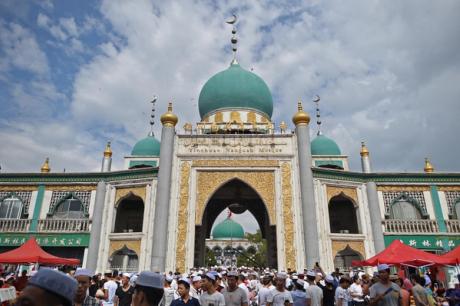China closing or repurposing mosques in northern Muslim regions, Human Rights Watch finds


Mainland China’s government has demolished or closed a substantial number of mosques in Gansu Province and the Ningxia Autonomous Region since 2020—or repurposed or removed their Islamic elements such as domes and minarets—a new report released yesterday by Human Rights Watch (HRW) has found.
It documents what appears to be part of a larger—if inconsistent—campaign against religious and particularly Islamic heritage architecture in China. “We know that the Chinese government has also destroyed other important religious pilgrimage sites,” including the Ordam Mazar and Aksu sacred cemeteries in Xinjiang, Elaine Pearson, the Asia director of HRW, tells The Art Newspaper.
“There are several sacred sites across Xinjiang where there is a long Islamic tradition dating back some thousand years. In some places where tourists go, Muslim mosques and sites remain intact, such as Kashgar and Ürümqi, but that speaks to the way the Chinese government is selective in its approach,” Pearson says. “UN agencies that are responsible for cultural heritage protection like Unesco should be examining sites of religious significance along the Silk Road and elsewhere that are at risk and raising concerns with the Chinese government.”
In the report, HRW’s acting China director Maya Wang says: “The Chinese government’s closure, destruction, and repurposing of mosques is part of a systematic effort to curb the practice of Islam in China.”
The 2020 removal of the onion domes and other details of the Nanguan mosque in Ningxia’s capital Yinchuan was widely reported and condemned, but the HRW report reveals how widespread the practice has been.
Continuing Xi Jinping’s 2016 call for the “Sinicization” of religion, its so-called “mosque consolidation” policy was first outlined in an internal party document in 2018, which directed local governments to “strengthen the standardised management of the construction, renovation and expansion of Islamic religious venues.” It stressed that there should be no “newly built Islamic venues” in order to “compress the overall number [of mosques]”.
HRW’s report cross-references personal accounts, government documents, images posted by Hui Muslims and satellite imagery. However, due to a lack of official numbers, the organisation cannot determine exactly how many mosques have been impacted in the two northwestern areas that are home to significant numbers of Hui, a mostly Muslim ethnic minority in China.
In 2021, the US-based, non-profit media company Radio Free Asia reported that 400 to 500 of Ningxia’s 4,203 mosques had closed since 2014. A forthcoming report by the scholars Hannah Theaker and David Stroup estimates that a third of Ningxia’s mosques have been closed since 2020.
The report draws on the research of the Hui activist Ma Ju, who says the “consolidation” seeks to discourage worship by removing preachers’ podiums and ablution halls as well as external signifiers, while adding surveillance equipment to the mosques that remain. Opposition to the policy has resulted in the indictment of five Ningxia Hui who led 20 protesters to the village Party chief’s office in January 2021.
The two areas cited in the HRW report have China’s second and third largest Muslim populations after Xinjiang. Since 2017, two-thirds of the mosques in Xinjiang have been damaged or destroyed, according to the independent think tank Australian Strategic Policy Institute—half have been completely demolished.
China last experienced widespread mosque closure and demolition in the 1950s, after the 1949 Communist victory in the civil war. Even prior to the Cultural Revolution’s beginning in 1966, authorities had demolished or consolidated around 90% of Ningxia’s mosques. Of China’s 39,135 mosques in 2014 (24,100 in Xinjiang, 4,606 in Gansu and 4,203 in Ningxia), most were constructed after the Cultural Revolution in the late 1970s, when the government continued to regulate religion.
Source link





